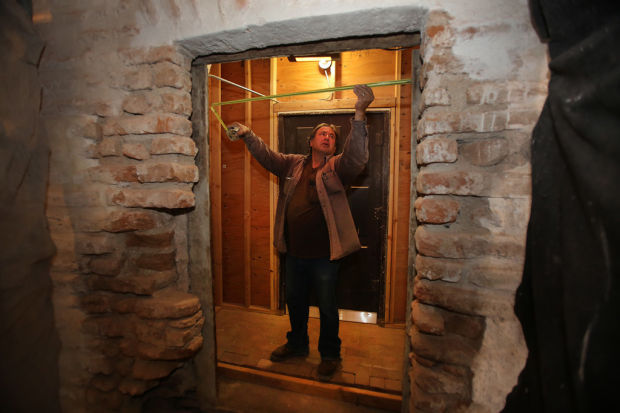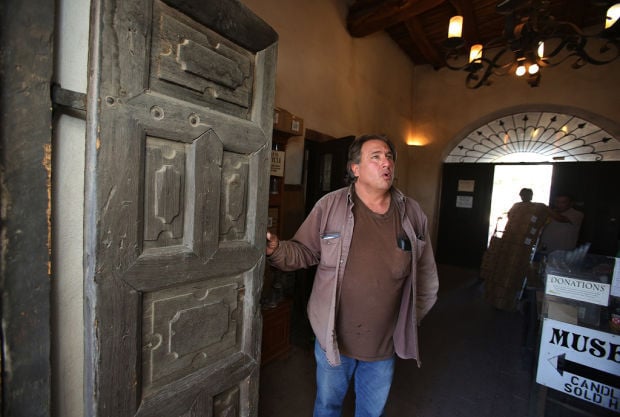Anyone who has remodeled an old house has made unexpected discoveries.
But such discoveries are extra special when the “house” in question is Mission San Xavier del Bac.
As the general contractor on the mission’s restoration work, Daniel Morales has come to know the spectacular structure inside and out. Literally. Recently he unraveled a long-held secret held within the White Dove of the Desert.
It turns out that a pair of weathered, wooden doors at the entryway to the mission’s candle shop date back to the late 1700s, when the mission was completed. The doors originally hung in the sala de profundis, the Chapter Room, at the sacristy arcade leading from the courtyard to the museum.
Morales said he made the connection while digging below the passageway to the Chapter Room, which the friars had originally used as a meeting room. Over the years it was used as a storage room and now is a museum. Initially there was a door at the passageway, which was later converted to a window. Morales’ task was to restore the doorway.
While digging and poking through various layers of mortar, Morales realized that two doors had hung in the passageway. He saw the hinge marks on the three-inch frame. He measured the opening, top to bottom, side to side.
“That’s when I noticed it,” he said. “Something just dawned on me.”
He measured the old, double doors at the candle shop. The dimensions fit the passageway to the Chapter Room.
The 52-year-old Morales, who has worked on restoration projects at the mission for 33 years, following his father’s and grandfather’s footsteps, made a leap of faith.
“Those were the doors,” he said Thursday morning at the Mission, which was crowded with the faithful. It was the eve of the Oct. 4 feast day of St. Francis of Assisi, one of the mission’s most revered saints.
To confirm his finding, Morales turned to two experts on the mission, retired anthropologist Bernard “Bunny” Fontana and the renovation’s architect, Bob Vint. They both believe Morales is correct.
“I can think of no reason why that may not have been the case,” Fontana wrote me. “I regret to say I have never paid any attention to those doors, much less examined them closely. I’m guilty of simply having taken them for granted.”
Vint believes Morales’ discovery of the 200-year-old doors “hiding in plain sight” is significant.
The doors were likely placed in their present location before the 1940s, said Vint, based on the mission’s architectural renderings at that time.
“I’m certain these are the original doors. The materials, workmanship and joinery are all similar to the other doors at the mission,” wrote Vint in an email. “Plus Danny’s observation that the door size, shape and pattern of hinges exactly match the frame at the Chapter Room is conclusive.”
Discovering the original doors is part of the painstaking puzzle that is Mission San Xavier, a National Historic Landmark. The Tohono O’odham and Franciscans built the mission between 1783 and 1797, about 100 years after the arrival of Jesuit Eusebio Franciso Kino to the village of Wa:k. Restoring it and re-creating it as much as possible has been a challenge for the Patronato Mission San Xavier del Bac, the nonsectarian, nonprofit support group founded in 1978.
The current project — the restoration of the sacristy arcade — is more than 3 years old. The arcade was the first addition to the main church in the early 19th century. The next project, if there is sufficient funding, will be the restoration of the east tower.
Morales said much of the arcade work required reinforcing or pouring new foundations under the wall separating the arcade and east transept of the main church. The support under the piers of the arcade was unstable as well.
The restoration workers poured a lime-and-concrete mixture that is compatible with the original brick and mortar. On the walls workers have applied lime and sand plaster.
Two of the workers are Morales’ father, Apolino “Sonny,” 79, and his son Vincent, 24. Five generations of Moraleses, including grandfather Apolino Sr. and great-grandfather Ernesto have been restoring the mission since the 1950s.
Morales is thrilled to find an original link to the mission.
Fontana, who authored the tome, “A Gift of Angels: The Art of Mission San Xavier del Bac” on the UA Press, wrote me about one of his most memorable discoveries.
When conservators completed their interior restoration work in the late 1990s, a revelation came to them. The large painting on the north wall, known as El Buen Pastor (Christ the Good Shepherd) turned out to be La Divina Pastora (Mary the Good Shepherdess).
“What had formerly been seen as a beard on the figure’s face turned out after cleaning to be part of Mary’s head covering,” he wrote.
Ah, the revelations.





